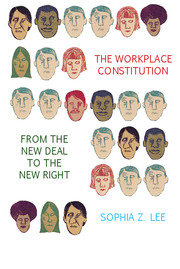Book contents
- Frontmatter
- Contents
- Acknowledgments
- Introduction
- Part I Crafting the Workplace Constitution in the New Deal 1930s and 1940s
- 1 Liberals Forge a Workplace Constitution in the Courts
- 2 Agencies Discover the Liberal Workplace Constitution
- 3 Conservatives Create a Workplace Constitution in the Courts
- Part II Advancing the Workplace Constitution in the Cold War 1950s
- Part III Administering the Liberal Workplace Constitution in the Long 1960s
- Part IV The Workplace Constitution in the New Right 1970s and 1980s
- Epilogue
- Appendix: Figures
- Notes
- Selected Bibliography of Primary Sources
- Index
2 - Agencies Discover the Liberal Workplace Constitution
Published online by Cambridge University Press: 05 October 2014
- Frontmatter
- Contents
- Acknowledgments
- Introduction
- Part I Crafting the Workplace Constitution in the New Deal 1930s and 1940s
- 1 Liberals Forge a Workplace Constitution in the Courts
- 2 Agencies Discover the Liberal Workplace Constitution
- 3 Conservatives Create a Workplace Constitution in the Courts
- Part II Advancing the Workplace Constitution in the Cold War 1950s
- Part III Administering the Liberal Workplace Constitution in the Long 1960s
- Part IV The Workplace Constitution in the New Right 1970s and 1980s
- Epilogue
- Appendix: Figures
- Notes
- Selected Bibliography of Primary Sources
- Index
Summary
The NLRB: “... a little FEPC”?
Clarence MitchellIn 1941, George Benjamin became the first African American vice president of the Tobacco Workers International Union, an American Federation of Labor affiliate. For decades the Tobacco Workers had mostly ignored black workers. In 1930, only 100 of its 3,000 members nationwide were black. By the early 1940s, however, the union was scrambling to improve those numbers. The National Labor Relations Board had initially let unions define the group of workers they wanted to represent. Recently, however, it had required that the “bargaining units” have an economic justification, not merely a racial one, ending the Tobacco Workers’ practice of targeting a plant’s white workers only. Meanwhile, rival Congress of Industrial Organizations unions had steadily organized black workers at tobacco processing plants around Richmond, Virginia, getting a head start on winning their allegiance. Benjamin was a skilled and tested organizer, adept at operating within the constraints of Jim Crow. The Tobacco Workers’ new president wanted Benjamin to help the union organize “at least 90% of the colored workers” in Richmond. Unfortunately, it was “still in the minds of some of the people that our international don’t want the Negro,” Benjamin warned. Richmond’s Larus & Brother tobacco plant became the testing ground for the Tobacco Workers’ new strategy.
Instead of the racial exclusion so common among the railway brotherhoods, the Tobacco Workers organized African Americans into segregated locals. “I am not telling you that [Tobacco Workers] Local 219 will not bargain for you,” Benjamin informed Larus & Brother’s African American workers. “But ... my experience in the labor movement [is] that it would be better ... to be in a local union to [your]selves.” With the CIO promising them an interracial union, Larus & Brother’s black workers had to weigh the merits of segregated versus interracial membership.
- Type
- Chapter
- Information
- Publisher: Cambridge University PressPrint publication year: 2014



